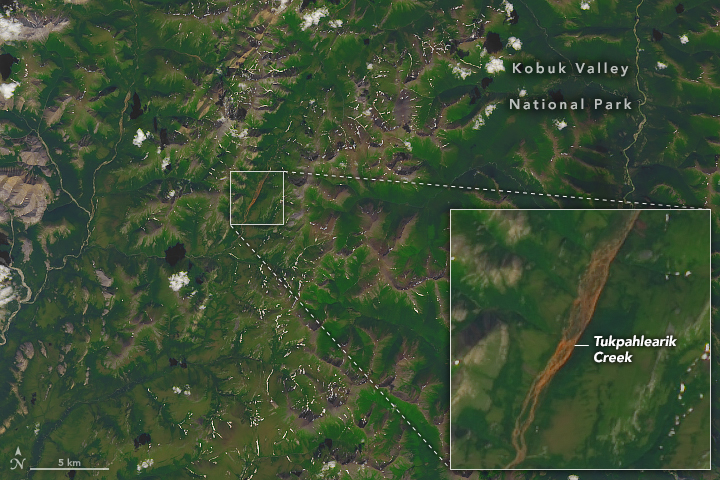Rusting Rivers
Jan 16, 2024
Today’s story is the answer to the January 2024 puzzler.
Scientists are keenly aware that losing permafrost—the year-round frozen ground prevalent across the Arctic—generally does not bode well for the planet’s future. The thawing of this frozen layer releases the potent greenhouse gas methane, thereby feeding more warming and thawing, while also destabilizing the ground and potentially letting loose dormant pathogens.
Researchers suspect that thawing permafrost is also the cause of dozens of Alaskan streams turning orange. Along with the strange appearance of the water, they have found it tends to be higher in iron, lower in dissolved oxygen, and more acidic than nearby rivers that run clear.
Tukpahlearik Creek is one such stream that has taken on a new hue. The OLI-2 (Operational Land Imager-2) on Landsat 9 captured this view of its rusty waters on July 23, 2023. The creek runs through northwest Alaska, adjacent to Kobuk Valley National Park and north of the Arctic Circle.
The exact reasons for the orange appearance and altered chemistry of such streams are still a matter of debate, but a couple of hypotheses have emerged. One says that, along with methane, bacteria are producing a reduced, soluble form of iron as they digest plant and animal matter in thawing permafrost soils. As that iron reaches flowing streams, it can become oxygenated, or “rust,” and turn the water orange.
Another idea, not mutually exclusive to the bacterial process, posits that water is encountering bedrock rich in sulfide minerals underneath thawing permafrost, something that has likely not occurred in thousands of years. Ensuing chemical reactions spike the water with sulfuric acid. What’s more, that acidic water may then leach heavy metals from rocks and carry them downstream. The processes are similar to those that pollute water near mining activity.
Altered water chemistry degrades habitat for fish, small aquatic animals, and insect larvae. Precipitated iron can hinder fish respiration and smother their eggs, among other effects. The dramatic shift in water quality may be felt most acutely in the villages that rely upon rivers originating in permafrost regions for fish and drinking water.
NASA Earth Observatory image by Ross Walter and Michala Garrison, using Landsat data from the U.S. Geological Survey. Story by Lindsey Doermann.
